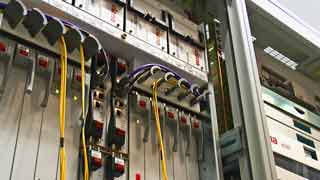What is NFV: network functions virtualization basics
NFV, network functions virtualization is an approach to telecommunications networking that is growing rapidly in its use.
NFV, Network Functions Virtualisation Includes:
NFV basics
Virtualised network functions, VNF
Network Functions Virtualization, NFV is an approach to telecommunications networking where the network entities that traditionally used dedicated hardware items are now replaced with computers on which software runs to provide the same functionality.
By running a network based around NFV, Network Functions Virtualization techniques, it is easier to expand and modify the network, and it is able to provide considerably more flexibility as well as being able to standardise on much of the hardware as it consists of additional computing power. In this way costs can be considerably reduced.

Network functions virtualization background
Traditional physical network hardware has always been difficult to change and upgrade. Introducing a software patch or rolling out a new service on a physical network can take months to complete. This is both time consuming and costly.
As a result, Over-The-Top, OTT operators have been able to gain a significant market foothold as they only utilise the network and do not inherit its problems. The OTT operators can launch a software-based internet platform that can be deployed almost immediately and run over the top of existing hardware.
NFV, network functions virtualization started in with mobile telecommunications networks with the promise of making networks more flexible and far easier to upgrade and change.
The concept of network functions virtualization was first introduced this concept in November 2012 as part of the ETSI ISG to provide hardware-related CAPEX and OPEX reductions.
As more developments have been made with NFV, service agility has become one of the main drivers for the development of network functions virtualization.
NFV Network Functions Virtualization basics
NFV, network functions virtualisation is a concept that virtualises major elements of a network. In this way, rather than having a dedicated item of hardware to provide a given function, software running on a computer / server is used.
In this way entire classes of network node functions can be set up as building blocks that can be connected to create overall telecommunications networks.
NFV utilises traditional server virtualisation, but extends the concept significantly. In this way one or more virtual machines running different software and providing different processes, on top of industry standard high volume servers, are able to provide the functions of switches and storage, or even cloud computing infrastructure, instead of having custom hardware appliances for each network function.
Examples of the virtualised functions that can be provided include: virtualized load balancers, firewalls, intrusion detection devices, WAN accelerators, routers, access control and billing.
NFV framework
As with any system, a network using NFV techniques can be broken down into a number of elements. Those for Network Functions Virtualization are:
- Virtualized network functions, VNF: The virtualised network functions comprise the software used to create the various network functions in their virtualised format. These are then deployed onto the hardware, i.e. the Network Function Virtualization Infrastructure.
- Network function virtualization infrastructure, NFVI: The NFVI consists of all the hardware and software components which are contained within the environment in which VNFs are deployed.
One of the advantages of NFV is that the NFV-Infrastructure, NFVI can be located across several physical locations, allowing operators to typically place their centres at the most convenient locations. The network providing connectivity between these locations is part of the NFV-Infrastructure. - Network functions virtualization management and orchestration architectural framework, NFV-MANO Architectural Framework: NFV- MANO consists of the various functional blocks in whatever form that enables the exchange information, manipulation and storage needed manage and run the NFVI and VNFs, the network to operate correctly and provide significant improvements in efficiency and performance over other forms of network.
The NFVI and the NFV-MANO areas of the network are built within the overall NFV platform. This platform implements carrier-grade features used to manage and monitor the various components, recover from failures and provide effective security. These functions are all needed to run a public carrier network.
Difference between NFV & SDN
Network functions virtualisation and software defined networking are very closely linked, but they are not the same. Often the terms are incorrectly used synonymously.
The main points of each are summarised below so that both SDN and NFV can be evaluated with their similarities and differences.
- Software Defined Networking, SDN: SDN deals with the replacement of standardised networking protocols with centralised control. As a result, SDN promisss to reduce the complexity of distributed networking control protocols with the simplicity of programming an overall controller. As such this significantly improves the flexibility as only a single instance needs updating to reflect a change.
Thus SDN separates the network control and forwarding planes and provides a central view for more efficient implementation and running of the network services. - Network Functions Virtualisation, NFV: NFV replaces the proprietary network elements of NEs with software that runs on standard servers. In other words NFV focuses on optimising the network services themselves.
This technique decouples the network functions from proprietary hardware, placing them on more generic servers or computers so these functions can run in software to provide more flexibility for operation, changes and updates.
Although the two technologies are similar in as much as they both use software, they are in reality very different, achieving different goals. The differences between NFV and SDN mean that they are can both techniques be used on the same network in a mutually beneficial manner.
 Written by Ian Poole .
Written by Ian Poole .
Experienced electronics engineer and author.
Wireless & Wired Connectivity Topics:
Mobile Communications basics
2G GSM
3G UMTS
4G LTE
5G
Wi-Fi
Bluetooth
IEEE 802.15.4
DECT cordless phones
Networking fundamentals
What is the Cloud
Ethernet
Serial data
USB
LoRa
VoIP
SDN
NFV
SD-WAN
Return to Wireless & Wired Connectivity



